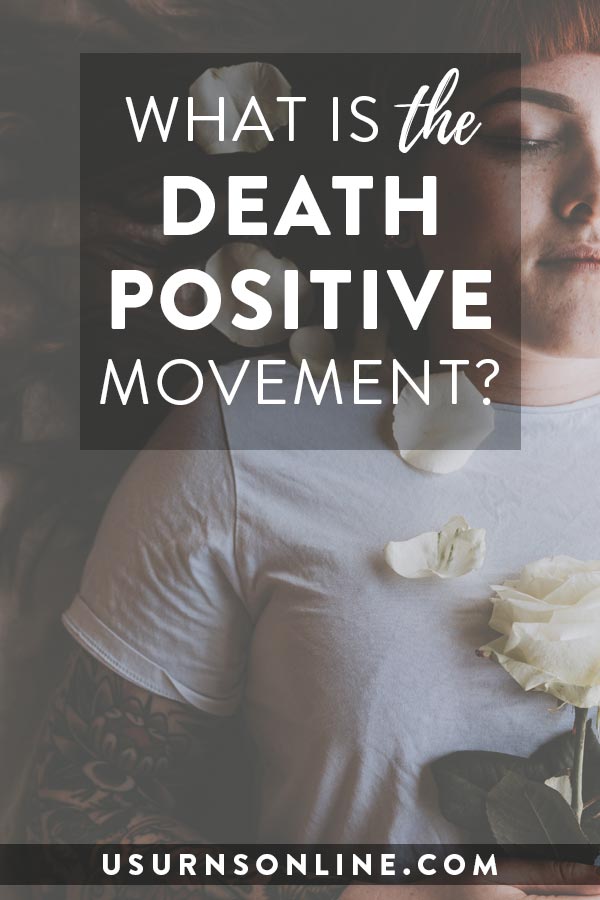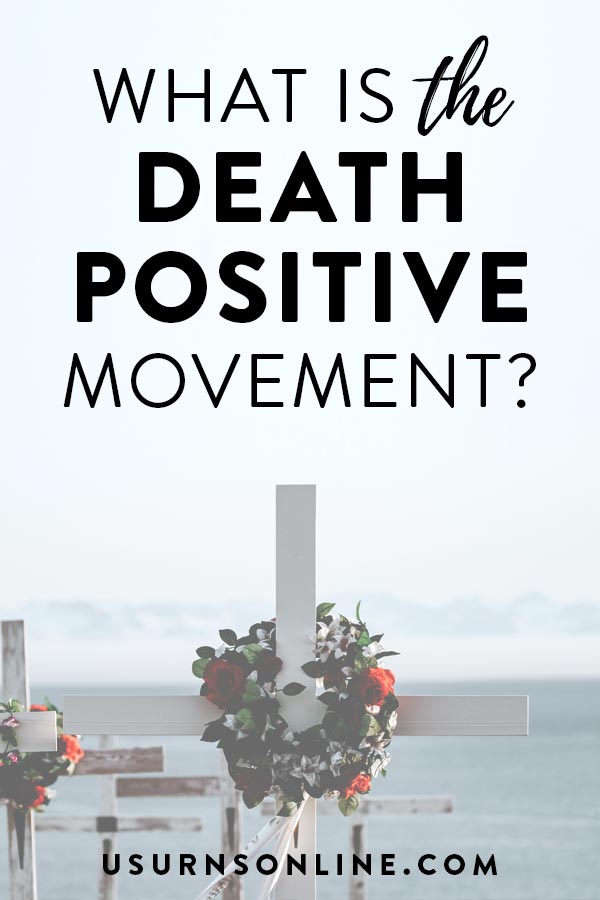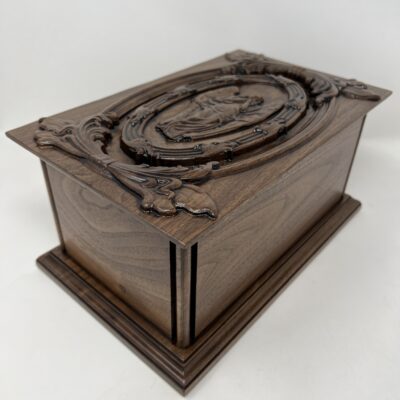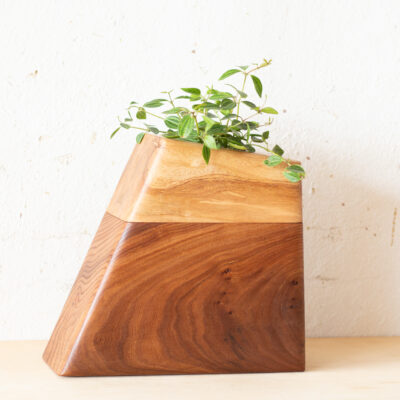Maybe you’ve heard the term “death positive.” What is it? An attitude, a movement, a philosophy? How can you be “death positive,” and is this something you should want?
When you hear the word “funeral,” you probably get some sort of image of suits and ties, black dresses and veils, a stately church or chapel, a heavy casket. Words like grief, dreary, formal, morose, sad, depressing, cemetery, expensive.
How about the word “death”? What comes to mind? Do you think macabre, gothic, dark? Or pain, loss, cancer, grief?
Or is it more of a mystery? Perhaps a sheet drawn over a face, a hospital door closing, a tombstone, a casket open but you have that twinge of fear which prevents you from peeking over the edge…
Whatever comes to mind when you think of “funeral” or “death,” I’d guess it is not a good or positive association.
What, then, is this about a “death positive” movement?
Our website is supported by our users. We sometimes earn a commission when you click through the affiliate links on our website. See our privacy policy & disclosures for more information.
What Does “Death Positive” Mean?
To be Death Positive means to accept death as a natural part of life, and don’t treat it as taboo. Death positivity recognizes that talking about and planning for death is appropriate, healthy, and even normal.
This might include frank discussions about the process of dying, what happens to bodies after death, death rituals and traditions, options for burial, funerals, body disposition, and ceremonies to honor a person’s legacy.
The Death Positive Movement
The Death Positive movement encourages people to think and talk freely about death.
Urns Made in the USA
Distinctives include a focus on family-centered funerals, hands-on participation in the body preparation and burial/cremation, at-home burials, “green” and natural burial options, more affordable burial and cremation choices, meaningful rituals and ceremony, and an acceptance of death and decay (not to mention renewal) as part of the natural world.
The main idea is that, when we talk openly and thoughtfully about what many consider a “taboo” topic, it will help alleviate the fear and anxiety surrounding death and enable consumers to make informed, satisfying, and environmentally conscientious choices.
Specifically, the Death Positive movement is influenced by the work of anthropologist Ernest Becker in his Pulitzer-prize winning 1973 work The Denial of Death. The term “death positive” was coined by author, YouTube personality, and mortician Caitlin Doughty, who was heavily influenced by Becker. The Death Positive movement itself is largely centered around Doughty’s work but draws from a broader stream of writers and thinkers.
Those who identify with the Death Positive movement are many and varied. Some work at traditional funeral home chains while others are independent morticians; some work in hospice or palliative care while others are bloggers and writers.
How to Be Death Positive
These are some of the emphases and common tendencies of the Death Positive movement.
1. The death industry has become professionalized and thus remote
Commercialized Western culture emphasizes life rather than death.
We’ve placed dying in the sphere of the doctor and hospital, and funeral arrangements into the sphere of the professional mortician. In doing so, our culture has removed the care of our dead away from families and loved ones. This takes death out of our thoughts and practice, and makes it all the more jarring when we have to face it.
Instead of outsourcing death, we should embrace it as a natural part of life. Acceptance – even in advance – is the first step in genuine healing.
We can and should begin to overcome this by talking about death in a constructive way.
2. Insistence that people should be involved – as much as they wish to be – in the care for their own dead
The laws that govern death and end-of-life care should ensure that the person’s wishes are honored. If they wanted to die at home, surrounded by friends and family, that should be a priority.
Family-centered funerals can be the norm. Instead of sitting at a desk or table at the funeral home, these conversations can happen around the family dinner table.
Of course, everyone should be equally free to invite funeral directors and other professionals into the process. But the first priority should be what the decedent wanted, followed by what the family is able and willing to do to honor their beloved one.
3. “Green” and natural burial options should be available to all
“Going green” has hit the funeral industry in a big way. People are more concerned than ever about the environmental impact of death, and the industry is responding. There are eco-friendly caskets, biodegradable cremation urns, new methods of “cremation” like alkaline hydrolysis, and much more. These options have many advocates among the Death Positive crowd.
But perhaps the most specific “green” trend is natural burial. This is where a body is buried as naturally as possible, typically in a burial shroud or simple pine casket.
The body is not embalmed, so no chemicals are used. Rather, the deceased’s loved ones help prepare the body and burial happens within just a few days of death.
While this seems quick, the idea is that this is the natural process. Like in times past, the family is with their loved one at the end, washing and dressing the body for burial, and sometimes even digging the grave themselves. Many say there is a powerful sense of purpose and healing while they literally “work” through their grief.
If the green approach to burial interests you, read our Guide to Natural Burial.
4. Hands-on participation in the funeral, body preparation, and burial/cremation can have a healing effect
Because the last few generations have been raised on the idea that death care is the realm of the professionals, we can be very squeamish about the idea of caring for our own loved one’s bodies.
However, those who take on the primary role of caregiving at the time of death almost universally report greater comfort and healing, as well as more open and healthy grief.
They tend to their loved ones during the final days, allow death at home (as much as these things can be planned or controlled), and prepare their loved one’s corpse for burial or cremation. In so doing, they are nearby throughout all the stages of saying goodbye, and their closure can tend to be greater and fuller.
5. It it important to discuss your wishes prior to death with your loved ones
It’s fine to believe all this, but it doesn’t make a difference if you don’t actually talk to your family about it.
The Death Positive movement aims to inspire people to have these sorts of conversations about death and dying. What do you want to happen to your body? How would you like to be remembered and celebrated, grieved and honored? What do you want emphasized at your funeral? What is most important to you in life?
Talk about your plans with your loved ones. Write down your wishes, ask if your family would be willing to do various things, and ask for their input as well.
You may discover that these conversations unearth all sorts of things, from buried emotions to creative quirks to a new thoughtfulness about how to live your life meaningfully.
6. Incorporation of meaningful rituals and ceremony
The more you talk about these things, facing the idea of death head-on, the more able you will be to plan meaningful rituals as a part of your farewell.
You may discover an ancient practice that resonates with you, or perhaps you become convicted of the importance of donating your body to scientific research.
At the very least, you can indicate who you want involved, who you might choose to give your eulogy, what poems or Scriptures to read, what songs to play or sing, and so on.
Related: New & Old Funeral Traditions at Home & Abroad
7. Acceptance of death and decay as part of the natural world
In order to do all these things well, you must accept death as a natural part of this beautiful world. The Death Positive movement seeks to make this easier to do, so that you can approach the end of your life with peace, knowing that you have thought deeply about your end.
My Take on the Death Positive Movement
As someone who has been in the funeral industry for over 12 years, I’ve watched as cremation passed 50% of all dispositions and I’ve seen the mainstreaming of personalized “life celebrations” and have observed the increasing popularity of the green funeral and at-home funeral movements.
My opinion is that the overall feel of the Death Positive movement involves youthful zeal, eco-friendly practices, social media, an interest in the traditions of many diverse cultures, and a fascination with all things medieval, macabre, and Gothic.
Of course not everyone has the same interests and styles, but this is the vibe I get when clicking around the various websites, YouTube channels, and social media profiles of the louder voices in the movement. It is what I would consider quirky-yet-normal interests for those whose profession involves working with the dead.
The outlook of the Death Positive movement is that it’s ok to think and talk about death in positive terms. This doesn’t necessarily mean happy. Rather, these are positives such as:
- Learning. When we learn about death, the fear of the unknown gives way to a greater sense of peace that comes with knowledge and understanding.
- Planning. When we plan for our own eventual death, we will not worry about it as much, or cause our family additional stress when we die.
- Partaking. As we understand the dying process and our options, we can plan to include family and friends in the care and rituals so that they can partake in this final phase of our lives.
- Caring. By which I mean, caring for the environment and our family’s finances. There are many options available which will help you leave this world in a more affordable and environmentally-friendly way.
Pros & Cons
There are many, many positives that can come from regarding death more openly and honestly. These are just a very few. As fears and anxieties decrease, your relationships with your family, friends, and the world will often increase. Your costs go down, your options go up. This is the “positive” in the Death Positive movement.
The negative side to all this is that there is much more weight on the individual. No longer do we rely on established traditions, but there is immense pressure to reinvent the wheel at each person’s passing. It’s great to celebrate the unique individuality of each human being, of course, but because there is no longer any standard, families and friends always seem to wonder what they can do to make the experience as special, unique, and wonderful as their loved one.
So I think that the death positive movement is helpful where it encourages people to think and talk about death, to prepare and plan for the end of their life, and to consider their legacy. But the movement can add more pressure and confusion where it leads to the constant search for the unattainable perfect funeral or ideal death.
Other Similar Trends
There are several other trends that overlap with the Death Positive movement. These trends tend to share a passion to help people become more aware of their end-of-life options and enable them to plan their final days and funeral in a way that expresses their values and beliefs.
Other shared traits include a desire to talk more openly about death, dying, and funeral plans; concern for the environmental impact of the funeral industry; and a value for earthy, old-fashioned, and varied cultural traditions regarding death, grief, and body disposition.
End of Life Doulas
The end of life doula movement has quite a bit of overlap with the Death Positive movement, but one of the first differences you will notice is in their name. Despite the catchy and popular term “death doulas,” they prefer to be called “end-of-life doulas.”
This belies a deeper distinction between the doula movement and the Death Positives: Where the Death Positive movement focuses on death, end-of-life doulas emphasize people.
Again, before you go posting an angry comment, both trends have quite a bit of overlap. Many people are part of both. Doulas talk a-plenty about death, and those in the Death Positive movement want to help people.
But still, there are differences, and those differences, as far as I can tell, are that the Death Positive movement is a bit more philosophically zoned in on thinking through death and how our culture addresses (or fails to address) death, while the doula movement is about helping people one at a time through the dying process itself.
So, what is an end-of-life doula? Well, in much the same way that a birth doula is there to provide support, encouragement, and help to mothers bringing a child into the world, end-of-life doulas are there to provide support, encouragement, and help to the dying and their families as the dying person leaves the world. They advocate for the dying individual’s wishes first and foremost, while also providing guidance and advice where appropriate.
Read more: What Is a Death Doula?
Death Cafes
Death Cafes are local meetups where people (who might never otherwise have even met) gather together, share coffee or a meal, and talk about death. According to the Death Cafe website, the goal is to have a group-directed discussion on the topic of death with no agenda, objectives or themes. It is a discussion group rather than a grief support or counselling session.
As with the Death Positive movement, Death Cafes arise out of a recognition that death is often a taboo subject. Even though it is as much a part of life as birth, death is the one thing we all have to look forward to. But it’s hard to live your life to the fullest if you fear death. So what better way to overcome your fear than to talk about it?
That’s where Death Cafes can help. Check their website to see if there is an upcoming meetup in your area, or plan your own.
The Conversation Project
The Conversation Project is dedicated to helping people talk about their wishes for end-of-life care. Their stated goal is “to have every person’s wishes for end-of-life care expressed and respected.”
Many people arrive at death having never made their views, wishes, and preferences known. So they wind up dying in manner they would not have chosen, perhaps in a cold hospital room rather than at home surrounded by their loved ones. What is more, this sort of thing often leaves their beloved family and friends feeling guilty and uncertain, with the vague feeling that things should have been done differently.
To prevent this scenario, families need to talk about their end-of-life wishes beforehand. But the trouble is that this is the very thing that is hardest to do.
So The Conversation Project has made free conversation starter kits available for you to download. This will help you begin the conversation about death for yourself and your family members.
The kit guides you through many options by asking things like, “What’s most important to you as you think about how you want to live at the end of your life?” and “Who do you want to talk to about these things?”
Read Next: What to Post Online When Someone Dies





